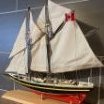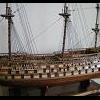-
Posts
213 -
Joined
-
Last visited
Reputation Activity
-
 Bender got a reaction from PaddyO in Ragusian Carrack by Bender - Marisstella - 1:59
Bender got a reaction from PaddyO in Ragusian Carrack by Bender - Marisstella - 1:59
Don, thank you much for your comments. It is alsways good reading your replies.
This is the same picture I posted in the above post, but this time I'll talk about the railing on the bridge deck that overlooks the main deck.
The kit doesn't come with any spindles. I bought these spindles from Model Expo many years ago.
I ran a brass wire all the way through the spindle so that the spindle is attached to the deck and the rail. The belt snapped on my mini drillpress last winter so I had to drill the hole with a handheld drill. My fingers got tired of holding the tiny spindles, so I made this simple holder.
I needed a bunch of them. Here are the spindles strung on the brass wire.
The bridge deck has a nice curve. I soaked and bent the rail to shape before drilling holes in it.
I made this jig to make sure I had the holes centered in the rail and evenly spaced.
I drilled one hole and then used a pin to hold the rail in position to dry the next hole.
After drilling all the holes in the rail, I used the rail to drill holes in the deck.
Here the railing in place.
-
 Bender got a reaction from PaddyO in Ragusian Carrack by Bender - Marisstella - 1:59
Bender got a reaction from PaddyO in Ragusian Carrack by Bender - Marisstella - 1:59
It seems like the rail would be high enough, but I guess these guys didn't want a sea monster climbing on board. This rail sits on top of the bridge deck railing. These are the rails at the left and right edge of the next picture.
and the top edge of this picture.
Each post leans in toward the center line. See the top picture. And sits vertical on the top rail that runs at a slope. See second picture. The Byrnes saw does not have a tilting blade, so I came up with this way of cutting the needed compound miter.
By placing this piece against the t-slide and holding the 4X4 Tilted back against this piece at 45*, and setting the t-slide at 73*, I was able to get compound angle.
I Used a spacer between the 4X4 and the saw fence to keep the cut piece from wedging between the blade and the fence and flying away.
You can see the gap between the piece and the fence.
I needed 14 posts but cut 25 pieces.
After cutting the 25 pieces, I needed to cut two slots in each post to except the horizontal rails.
Here the blade is 1.5 mm high.
My fingers were very close to the blade when I cut the slots. I couldn't get an actual picture of me cutting these pieces. By using the wood piece against the t-slide, I was able to keep my finger further from the blade than this picture shows.
Here is what the slots look like. I also drilled a hole in the bottom of each post and glued in a brass pin.
-
 Bender got a reaction from PaddyO in Ragusian Carrack by Bender - Marisstella - 1:59
Bender got a reaction from PaddyO in Ragusian Carrack by Bender - Marisstella - 1:59
I am posting my attempt at carving. The kit came with a laser cut sun, but I butchered it badly. This is my third attempt.
I copied the image and glued it onto a piece on boxwood.
Here a picture to show its size.
I first drilled holes at the base of the sun rays. It seemed to make it easier to stop at the correct spot when band sawing. I used three sizes of bits.
I then took out a little wood with a bandsaw.
Then I shaped the sun rays with a small bench belt sander.
I rounded the face.
I tried to carve the face by using the paper as a pattern, but it didn't work. I ended up needing to draw the face. I cannot draw.
The is about three hours in.
And this is the final result.
-
 Bender got a reaction from PaddyO in San Felipe by Bender - Mantua/Panart --Scale 1:75--Rebuild Log
Bender got a reaction from PaddyO in San Felipe by Bender - Mantua/Panart --Scale 1:75--Rebuild Log
HThis is a good picture that shows the sails.
For lines that are tied off at the pin rails, I work my way from the top down. For example: I start by attaching the line to the sail, run the line though all the blocks, and finish at the pin rail by poking the line through a hole in the pin rail. I press a pin in the hole to hold the line in place. When I’m finished with all the lines I can readjust the tension if needed. I don’t glue the pin in until I’m sure everything in in the correct spot, the tension is good, and no lines cross each other.
I finish up by making a bunch of rope coils and gluing them to each pin.
Some more pictures showing rope coils. And I had a few little plastic guys I painted and placed around the ship.
-
 Bender got a reaction from PaddyO in San Felipe by Bender - Mantua/Panart --Scale 1:75--Rebuild Log
Bender got a reaction from PaddyO in San Felipe by Bender - Mantua/Panart --Scale 1:75--Rebuild Log
Here’s some pictures of attaching sails.
-
 Bender got a reaction from PaddyO in San Felipe by Bender - Mantua/Panart --Scale 1:75--Rebuild Log
Bender got a reaction from PaddyO in San Felipe by Bender - Mantua/Panart --Scale 1:75--Rebuild Log
For the furled sails I attached them to the yard and coated them with diluted glue. I then tied loops around the sail were a line would crease the sail and let it dry. This process left the sail too bunched up and looking like a sail where weight was not pulling it down. After attaching the yard to the mast I sprayed the sail with more water and used a bunch of clips to give the sail the appearance of weight.
And it ends up lookin like this.
-
 Bender got a reaction from PaddyO in Tying blocks to yards or masts.
Bender got a reaction from PaddyO in Tying blocks to yards or masts.
I was asked to repost this. This is an easy way of tying blocks to yards or mast. I have also used this to tie blocks to the underside of tops.
I start out with thicker thread. A little trial and error with different threads to get the look I want. Notice I have the thread folded three times and use a clip to hold the thread tight.
I use smaller thread to wrap around the thicker thread. I start out with a slip knot tied in the thinner thread, and stick the loop and loose end of the thicker thread through the knot.
The thinner thread has two ends. The end that pulls the slip knot tight and the end the pulls the loop through the knot.
I pull the loop tight against the thicker thread and use a second clip to hold the thinner thread in place.
I start wrapping the thin thread (The end that pulls the knot tight.) around the three layer of thick thread and the loop of the thin thread.
I make 7 to 10 or more wraps. Trail and error to get the look.
While wrapping and after, you have to hold the wraps to keep them from unwinding. Remove the one clip. Take the end of the thread you've been wrapping and pass it through the loop of the thin thread.
Still while holding the wraps to keep them from unwinding, pull on the other end of the thin thread to pull the loop tight around the end of the thin thread. Pull the thin thread tight but not too tight. If is too tight, it will be hard to pull the thicker thread through. Also, as you pull on the end of the thinner thread it will pull the loop and the other end on the thin thread into the wrap.
You now have a loop and a loose end of thicker thread sticking out each end of the thinner thread. Pulling the loose end on one side pulls the loop in on the other side. Put a block in one loop and pull the loop tight.
Slip the other end over a yard or mast. You can also start out with the loop already around something.
Pull that loop tight.
Add a drop or two of CA glue, and when it is dry snip of the loose ends. This picture shows two block tie to a yard.
-
 Bender got a reaction from jenikstav in San Felipe by Bender - Mantua/Panart --Scale 1:75--Rebuild Log
Bender got a reaction from jenikstav in San Felipe by Bender - Mantua/Panart --Scale 1:75--Rebuild Log
I used my wife’s curling iron to give the flags a little bit of the “wind waving” look.
-
 Bender got a reaction from Major6 in Ragusian Carrack by Bender - Marisstella - 1:59
Bender got a reaction from Major6 in Ragusian Carrack by Bender - Marisstella - 1:59
Don, thank you much for your comments. It is alsways good reading your replies.
This is the same picture I posted in the above post, but this time I'll talk about the railing on the bridge deck that overlooks the main deck.
The kit doesn't come with any spindles. I bought these spindles from Model Expo many years ago.
I ran a brass wire all the way through the spindle so that the spindle is attached to the deck and the rail. The belt snapped on my mini drillpress last winter so I had to drill the hole with a handheld drill. My fingers got tired of holding the tiny spindles, so I made this simple holder.
I needed a bunch of them. Here are the spindles strung on the brass wire.
The bridge deck has a nice curve. I soaked and bent the rail to shape before drilling holes in it.
I made this jig to make sure I had the holes centered in the rail and evenly spaced.
I drilled one hole and then used a pin to hold the rail in position to dry the next hole.
After drilling all the holes in the rail, I used the rail to drill holes in the deck.
Here the railing in place.
-
 Bender got a reaction from Clark in San Felipe by Bender - Mantua/Panart --Scale 1:75--Rebuild Log
Bender got a reaction from Clark in San Felipe by Bender - Mantua/Panart --Scale 1:75--Rebuild Log
I used my wife’s curling iron to give the flags a little bit of the “wind waving” look.
-
 Bender got a reaction from bartejo in San Felipe by Bender - Mantua/Panart --Scale 1:75--Rebuild Log
Bender got a reaction from bartejo in San Felipe by Bender - Mantua/Panart --Scale 1:75--Rebuild Log
Here’s some pictures of attaching sails.
-
 Bender got a reaction from bartejo in San Felipe by Bender - Mantua/Panart --Scale 1:75--Rebuild Log
Bender got a reaction from bartejo in San Felipe by Bender - Mantua/Panart --Scale 1:75--Rebuild Log
I used my wife’s curling iron to give the flags a little bit of the “wind waving” look.
-
 Bender got a reaction from Clark in Reale de France by Clark – FINISHED - Corel - Scale 1:64
Bender got a reaction from Clark in Reale de France by Clark – FINISHED - Corel - Scale 1:64
Clark, it is good to see another Reale in the build logs. I look forward to your progress. That is a good idea how you used the wedge to keep the keel straight.
-
 Bender got a reaction from drobinson02199 in Cutty Sark by drobinson02199 - FINISHED - Mantua/Sergal - Scale 1:78
Bender got a reaction from drobinson02199 in Cutty Sark by drobinson02199 - FINISHED - Mantua/Sergal - Scale 1:78
David, your Cutty Sark looks great.
My first ship model was a Cutty Sark in plastic. I was a junior in high school back in 75. I built several more plastic over the next few years and moved to wooden when I was in my thirties. I’ve built 15 wooden ships and boats in the last 30 years. I want to build the Cutty Sark again and am always looking for the “best” wooden kit. This kit seems to be a top quality kit. After starting this kit and seeing other build longs, are you still happy that you chose this kit or do you sometimes think one of the other kits would have been better? Second question: Does the plans sheet include sail patterns?
Thanks for sharing your process.
-
 Bender got a reaction from GrandpaPhil in San Felipe by Bender - Mantua/Panart --Scale 1:75--Rebuild Log
Bender got a reaction from GrandpaPhil in San Felipe by Bender - Mantua/Panart --Scale 1:75--Rebuild Log
I used my wife’s curling iron to give the flags a little bit of the “wind waving” look.
-
 Bender got a reaction from BLACK VIKING in San Felipe by Bender - Mantua/Panart --Scale 1:75--Rebuild Log
Bender got a reaction from BLACK VIKING in San Felipe by Bender - Mantua/Panart --Scale 1:75--Rebuild Log
I used my wife’s curling iron to give the flags a little bit of the “wind waving” look.
-
 Bender got a reaction from GrandpaPhil in San Felipe by Bender - Mantua/Panart --Scale 1:75--Rebuild Log
Bender got a reaction from GrandpaPhil in San Felipe by Bender - Mantua/Panart --Scale 1:75--Rebuild Log
HThis is a good picture that shows the sails.
For lines that are tied off at the pin rails, I work my way from the top down. For example: I start by attaching the line to the sail, run the line though all the blocks, and finish at the pin rail by poking the line through a hole in the pin rail. I press a pin in the hole to hold the line in place. When I’m finished with all the lines I can readjust the tension if needed. I don’t glue the pin in until I’m sure everything in in the correct spot, the tension is good, and no lines cross each other.
I finish up by making a bunch of rope coils and gluing them to each pin.
Some more pictures showing rope coils. And I had a few little plastic guys I painted and placed around the ship.
-
 Bender got a reaction from marktiedens in San Felipe by Bender - Mantua/Panart --Scale 1:75--Rebuild Log
Bender got a reaction from marktiedens in San Felipe by Bender - Mantua/Panart --Scale 1:75--Rebuild Log
HThis is a good picture that shows the sails.
For lines that are tied off at the pin rails, I work my way from the top down. For example: I start by attaching the line to the sail, run the line though all the blocks, and finish at the pin rail by poking the line through a hole in the pin rail. I press a pin in the hole to hold the line in place. When I’m finished with all the lines I can readjust the tension if needed. I don’t glue the pin in until I’m sure everything in in the correct spot, the tension is good, and no lines cross each other.
I finish up by making a bunch of rope coils and gluing them to each pin.
Some more pictures showing rope coils. And I had a few little plastic guys I painted and placed around the ship.
-
 Bender got a reaction from GrandpaPhil in San Felipe by Bender - Mantua/Panart --Scale 1:75--Rebuild Log
Bender got a reaction from GrandpaPhil in San Felipe by Bender - Mantua/Panart --Scale 1:75--Rebuild Log
I tapered the masts and yards by chucking a piece of dowel in my drill and spinning the dowel against a bench top belt sander. When the dowel was nearly the correct size, I finished up by spinning the dowel inside a piece of folded over fine sandpaper.
I came up with a “cheat” for tying blocks to yards, masts, and tops. I made a crude drawing.
The thinner thread—with ends marked A and B—can be wrapped around the thicker thread four times to as many as ten or more depending on the length you need.
I usually tighten the thread around the block first and then slip the other loop around the yard or mast.
A drop of CA glue holds it. I’ve never had a block come loose using this method.
If the block is attached to an eye, I thread the string through the eye and then do the tying as shown in the crude drawing above.
Here is a link to a post I made several years ago that better explains this method.
http://modelshipworld.com/index.php/topic/1056-tying-blocks-to-yards-or-masts/?p=17489
-
 Bender got a reaction from GrandpaPhil in San Felipe by Bender - Mantua/Panart --Scale 1:75--Rebuild Log
Bender got a reaction from GrandpaPhil in San Felipe by Bender - Mantua/Panart --Scale 1:75--Rebuild Log
I had ordered sails from Model Expo, knowing they were back ordered. (Remember this was back in 2009.) I had been sitting around looking at the ship, wanting to do something. So I decided to try my hand at making sails. The kit comes with sail patterns. Sewing machines are not easy to use. It is easy to sew but not easy to sew in a straight line. Making a hem tiny enough for a model ship takes more practice than I have patience for, not to mention all of the parallel stitches one would have to do. First attempt found the trash. After reading more posts and tutorials here on MSW and reading on the model shipwrights’ database, I found out they make stuff for stitchless hems. You just place the stuff within the fold of the material and iron the hem. Works great. I found some thin cotton that already had the parallel lines. (Is that cheating?) I hand sewed the clew lines on and stuck myself several times. On the model shipwrights’ database, under sail making, I found several ways of making the sail appear to be windfilled. While ironing the hem, I put wire in the hem. Then after attaching the sail to the yard I made a sling in the bathroom sink (lavatory in the water closet.)
Then I moistened the sail, put a little glue on it, then smoothed out the glue until the sail was evenly covered with the diluted glue.
I laid little plastic bags of pea gravel on the sail and let the sail dry.
When the sail was completely dry I took it to the back porch where I made another sling to hold the sail and sprayed it with lacquer.
These pictures were of my third attempt for this one sail. I ended up emailing model expo to cancel the back order for the sails. It had been over two months.
You can see that the sail presses against a fore stay, which is the reason for the dowel that is crossways to the yard in the above pictures.
-
 Bender got a reaction from GrandpaPhil in San Felipe by Bender - Mantua/Panart --Scale 1:75--Rebuild Log
Bender got a reaction from GrandpaPhil in San Felipe by Bender - Mantua/Panart --Scale 1:75--Rebuild Log
Here’s some pictures of attaching sails.
-
 Bender got a reaction from GrandpaPhil in San Felipe by Bender - Mantua/Panart --Scale 1:75--Rebuild Log
Bender got a reaction from GrandpaPhil in San Felipe by Bender - Mantua/Panart --Scale 1:75--Rebuild Log
Here’s some pictures of attaching sails.
-
 Bender got a reaction from GrandpaPhil in San Felipe by Bender - Mantua/Panart --Scale 1:75--Rebuild Log
Bender got a reaction from GrandpaPhil in San Felipe by Bender - Mantua/Panart --Scale 1:75--Rebuild Log
For the furled sails I attached them to the yard and coated them with diluted glue. I then tied loops around the sail were a line would crease the sail and let it dry. This process left the sail too bunched up and looking like a sail where weight was not pulling it down. After attaching the yard to the mast I sprayed the sail with more water and used a bunch of clips to give the sail the appearance of weight.
And it ends up lookin like this.
-
 Bender got a reaction from fnick in San Felipe by Bender - Mantua/Panart --Scale 1:75--Rebuild Log
Bender got a reaction from fnick in San Felipe by Bender - Mantua/Panart --Scale 1:75--Rebuild Log
Notes from 8/6/2009
Everything is built: nothing but rigging left. Although, I am still trying to build a ship’s boat by scratch. Two attempts have left me with nothing I would want to show off. I will try one more time. If after this third attempt and the ship’s boat does not look good I will go with the kit supplied plastic/ wood boats.
I have all the standing rigging on the bowsprit, all the forestay on the fore mast except for the fore topgallant stays, the ten shrouds on the fore mast, and one fore stay on the main mast attached.
A thought occurred to me at this point: There are 10 shrouds each side on the fore mast, the main mast will have 12 shrouds each side and the mizzen mast 6 shrouds each side. I started thinking: that’s going to be a lot of ratlines. . . a lot of ratline knots. So I multiplied shrouds by ratlines, added up those from each mast and came up with 3110 knots. The plan—when the time comes—is to tie 100 knots a day for 31 days. We will see. Rigging really is my favorite part. I have decided to add sails; this requires 96 additional blocks tied to masts, yards and stays.
-
 Bender got a reaction from GrandpaPhil in San Felipe by Bender - Mantua/Panart --Scale 1:75--Rebuild Log
Bender got a reaction from GrandpaPhil in San Felipe by Bender - Mantua/Panart --Scale 1:75--Rebuild Log
Pictures of ratline tying. I used Microsoft Excel to print parallel lines the correct distance apart to keep the ratlines straight, level, and uniform.





